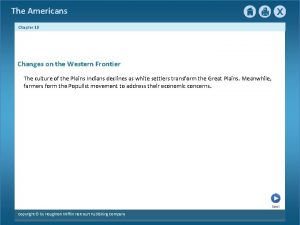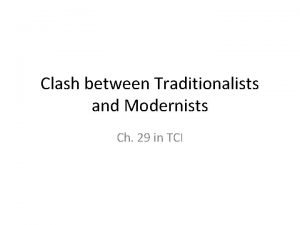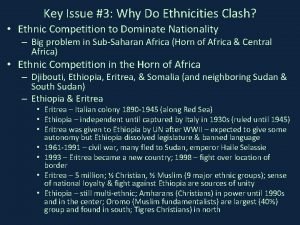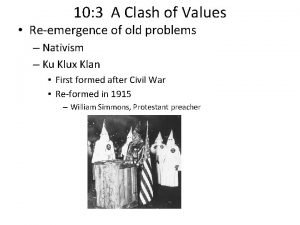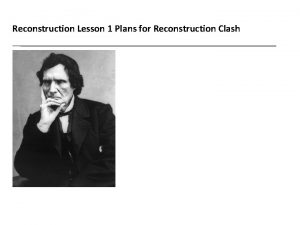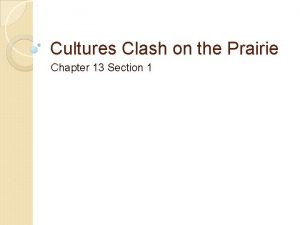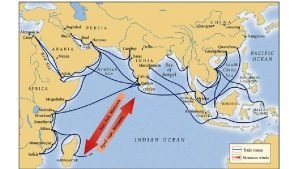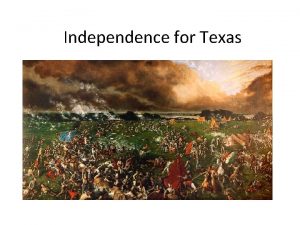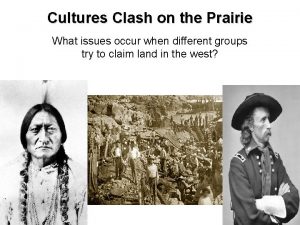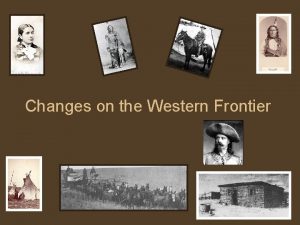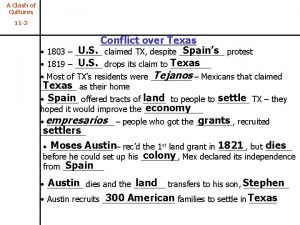Chapter 5 A Clash of Cultures STUDY PRESENTATION


























- Slides: 26

Chapter 5: A Clash of Cultures STUDY PRESENTATION © 2013 Clairmont Press

Section 1: Treaties Section 2: Trails of Tears

Section 1: Treaties Ø Essential Question: • How did various treaties cause the westward movement of American Indians? 3

Section 1: Treaties Ø What terms do I need to know? • • • impressment Missouri Compromise migrate cede subsistence 4

Introduction Ø President Jefferson wanted treaties between Indian nations and the United States for the security of the new country. Ø Treaties were used to gain land more rapidly, increase trade, and encourage Indians to adopt a European way of life. Ø Western land could be traded to the Indians for their eastern lands, but no one knew the U. S. would eventually reach from coast to coast. 5

Ø Ø Ø Ø New States The Northwest Ordinance (1787) said territories could apply for statehood when they had 60, 000 people. In 1812, the Territory of Orleans became the state of Louisiana. Oklahoma became a part of Missouri Territory. In the War of 1812, the U. S. fought Britain which resulted in clear boundaries for the U. S. and proved America’s strength. In 1819, Oklahoma became part of the new Arkansas Territory. Missouri Compromise (1820): Henry Clay’s solution to keep balance of free and slave states with no slaves in the rest of Louisiana Purchase lands. Kansas-Nebraska Act (1854): abolished the Missouri Compromise by allowing slavery in Kansas. Dred Scott was a Supreme Court decision which said Congress could not stop slavery in new territories. 6

Missouri Compromise 7

Early Migrations Ø Ø Ø Plains Indians roamed areas of 500 -800 miles; many tribes roamed through Oklahoma. The Wichita tribe was known as reliable and hospitable; they grew corn, pumpkins, beans and tobacco. The Caddo tribe lived in SE Oklahoma. Their numbers decreased after the Louisiana Purchase due to war and disease. The Comanche tribe moved into the area in the 1700 s and were known for horses, hunting, and warfare. The Kiowa tribe moved to plains in late 1700 s. 8

Early Migrations (cont. ) Ø Ø Ø Ø The Kichai moved from Texas and Louisiana to western Oklahoma by the 1800 s along with the Shawnee and Delaware Indians. Osage territory spanned a large area of Oklahoma in the 1700 s (Missouri to Arkansas rivers) and often fought with other tribes coming into the area. Salina was the earliest permanent white settlement in Oklahoma. It was originally a trading post. The Quapaw Indians were more peaceful residents of eastern Oklahoma; treaties, disease and conflict with other tribes forced their movement. The Western Cherokee from along the Tennessee River often fought with Osage. Lovely’s Purchase Treaty (1816) failed to stop the fighting. Fort Smith built in Arkansas Territory in a failed attempt to stop fighting among the tribes. 9

Early Forts Ø 1824: The first fort was built in Indian Territory – Cantonment Gibson (Fort Gibson in 1832). Ø The Osage gave up Oklahoma lands in 1825 and moved to Kansas. Ø Additional roads, plank bridges, cantonments, and forts expanded trade with the west. 10

Early Indian Territory 11

Cherokee Outlet Ø 1828: The treaty with Western Cherokees moved them west from Arkansas and reset the boundary for Indian Territory. Ø The Cherokee got 7 million acres in northeast Oklahoma and a perpetual 60 -mile wide strip west called the “Cherokee Outlet”, $50, 000 plus additional funds. Ø Eastern Cherokee were offered to participate, but few took the offer. Return to Main Menu 12

Section 2: Trails of Tears Ø Essential Question: • How did the U. S. force the removal of southeastern Indians to Indian Territory? 13

Section 2: Trails of Tears Ø What terms do I need to know? • • • assimilation syllabary Indian Removal Act allotment lottery 14

Removal Ø President Andrew Jackson (1829 -1837) advocated removal as best for whites and Indians. Ø He supported removal of all Indians, even those that had adopted the lifestyle of the European. Americans. Ø Oklahoma, Kansas, southern Nebraska, and eastern Colorado became “Indian Territory” in 1834. 15

The Five Tribes Ø Ø Ø Ø Five major tribes of the southeastern U. S. were the Choctaw, Creek, Chickasaw, Cherokee, and Seminole. The U. S. government and various churches had been working to educate and Christianize the Indians. They were known as “civilized tribes” because many had adopted the ways of the European-Americans. Many in the Five Tribes operated large farms and raised livestock. Sequoyah invented a Cherokee syllabary, an alphabet based on syllables, for the Cherokee language. The Cherokee developed a constitution based on the U. S. Constitution with a capital at New Echota, GA. Worcester v. Georgia: Supreme Court sided with the Cherokee ruling that their lands were protected, but President Jackson refused to enforce the ruling. 16

Indian Removal Act Ø 1830: Congress passed a law to negotiate treaties to get tribes to move west of the Mississippi River. Ø Those who stayed would become citizens of the state, but many white settlers refused to accept the Indians’ presence. 17

Indian Removal Act: Choctaw Removal Ø Treaty of Doak’s Stand (1820) & Treaty of Dancing Rabbit Creek (1830): The Choctaw tribe agreed to relocate to Indian Territory in exchange for land money. Ø George Gaines was in charge of the removal for the Bureau of Indian Affairs. Ø Thousands of Choctaw encountered many problems with weather, transportation, and supplies. Ø More than 30% of the Indians died. Ø By 1834, about 8, 000 Choctaw had been moved to new lands in the west. 18

Indian Removal Act: Creek Removal Ø Muscogee (Creek) was a confederacy of tribes from Georgia and Alabama. Ø A series of treaties in the late 1820 s led to their migration to Indian Territory. Ø 1830: About 3, 000 Creeks lived in Indian Territory, but were facing raids by tribes already there. Ø 1836: Troops were sent to end the Creek War in Alabama which resulted from poor treatment of the Creek by white settlers. Ø Thousands died from exposure and disease on their way to Fort Gibson in 1837. 19

Indian Removal Act: Chickasaw Removal Ø An 1818 treaty reduced Chickasaw lands in Mississippi and the Treaty of Pontotoc Creek (1836) ceded the remainder. Ø Land could not be found for the Chickasaw, so they agreed to share lands with the Choctaw. Ø This was the smoothest removal with most able to take their personal property and limited loss of life in comparison to other tribes. 20

Indian Removal Act: Cherokee Removal Ø Ø Ø Ø 1828: Georgia refused to recognize the borders and sovereignty of the Cherokee nation about the time gold was discovered in the region. Though they won their Supreme Court case in Worcester v. Georgia, the President would not enforce the law. A lottery was held to offer the land to white settlers. One group of Cherokee, led by Major Ridge, signed the Treaty of New Echota (1835) and took money in exchange for land began move west. Chief John Ross and most Cherokee refused to leave and did not accept the treaty. Most of these were rounded up by federal troops and forced to march west. Weather and disease claimed about 4, 000 Cherokee in this “Trail of Tears. ” 1839: Ridge and other leaders were assassinated because of the treaty. Eastern and Western Cherokee adopted an “Act of Union” and became one nation with a new constitution in 1840. 21

Indian Removal Act: Seminole Removal Ø Seminole were the last tribe removed. Ø The Treaty of Moultrie Creek (1823) moved them to central Florida swampland. Ø By 1836, continued pressure caused some Seminole to move peacefully to Indian Territory. Ø The Second Seminole War (1835 -1842) was an expensive war for the U. S. who finally forced the remaining Seminole out of Florida. 22

Five Tribes in Indian Territory 23

Indian Removal Act: Other Removals Ø As more tribes arrived in the Oklahoma area, space for them became more scarce Ø Seneca, Euchee, Cayuga, and Kickapoo were among those joining existing tribes. Ø If possible, they joined or moved near to tribes that were of similar background. Ø The Kickapoo eventually moved to Mexico. 24

The Stokes Commission Ø The Federal Indian Commission (1832) was created to work out problems related to removal. Ø Montfort Stokes was the first chairman and worked hard for the Indian groups. Ø Stokes remained in Indian Territory the rest of his life. Ø The population grew as tribes adapted to the environment. Ø Washington Irving, Charles Latrobe, and Count Albert-Alexandre de Pourtales wrote popular accounts of their travels to the region. 25

Image Credits Slide 1: Daniel Mayer on Wikimedia Commons; Slide 2: Public Domain; Image Credits Slide: Thomas Jones on Wikimedia Commons Return to Main Menu 26
 Chapter 5 a clash of cultures
Chapter 5 a clash of cultures Chapter 13 section 1 cultures clash on the prairie
Chapter 13 section 1 cultures clash on the prairie Organizational behavior
Organizational behavior The comparative study of past and present cultures
The comparative study of past and present cultures Chapter 5 section 3 central european monarchs clash
Chapter 5 section 3 central european monarchs clash Chapter 29 the clash between traditionalism and modernism
Chapter 29 the clash between traditionalism and modernism Chapter 5 section 3 central european monarchs clash
Chapter 5 section 3 central european monarchs clash Chapter 20:1 operating the microscope
Chapter 20:1 operating the microscope Chapter 5 section 1 cultures of the mountains and the sea
Chapter 5 section 1 cultures of the mountains and the sea The collision of cultures chapter 1
The collision of cultures chapter 1 Why do ethnicities clash
Why do ethnicities clash A struggle or clash between opposing forces
A struggle or clash between opposing forces Clash royale clan manager
Clash royale clan manager Superordinate and hyponym
Superordinate and hyponym Clash of lights 10
Clash of lights 10 Red hot root words
Red hot root words Lesson 3 a clash of values
Lesson 3 a clash of values Scopes trial political cartoon
Scopes trial political cartoon X bogen clash of clans
X bogen clash of clans Wave onomatopoeia
Wave onomatopoeia Why did johnson and congress clash over reconstruction
Why did johnson and congress clash over reconstruction Clash of civilizations huntington
Clash of civilizations huntington Clash of civilizations huntington
Clash of civilizations huntington Andrew johnson’s plan
Andrew johnson’s plan Lol 450 champions
Lol 450 champions Hku add drop period
Hku add drop period Mc formers
Mc formers

